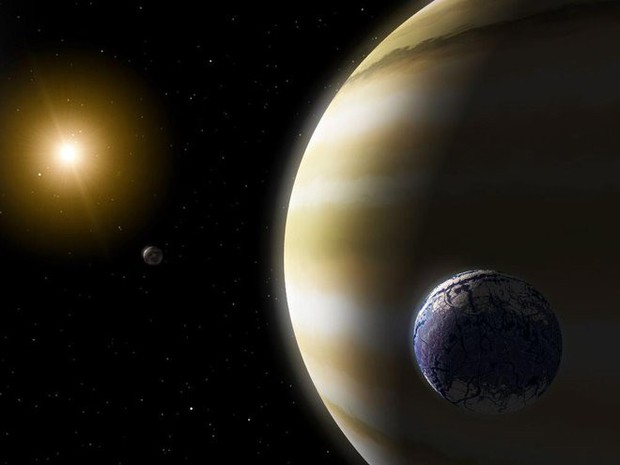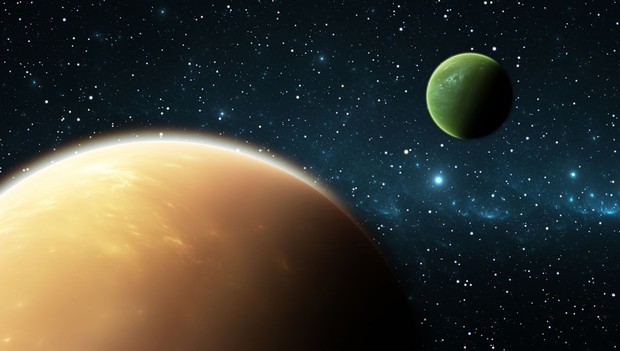Simply because it is the first moon outside the solar system to be discovered.
Moon (The moon is a natural satellite of the Earth, but not only the Earth has a Moon, in the solar system there are a total of 181 moons revolving around planets, of which 8 qualified planets represent more than 173 The 8 satellites remainder revolve around the dwarf planets.
In general, since there are so many moons, finding a new moon is not surprising. But there’s this news you might not know, that humans have never identified any moons outside of the solar system.
Planets outside the solar system are often referred to as exoplanets, so we can call the moons orbiting them as exomoons. But it wasn’t until 2017 that two Columbia University scientists, Alex Teachey and David Kipping, announced that they had found a candidate for the first exomoon title based on Kepler’s data.
And now, with data from the most powerful space telescope, Hubble, they have more evidence that the object is indeed a moon outside the solar system.
This may be the first time a moon has been identified outside the solar system.
David Kipping
“If Hubble’s data shows similar results, the study could provide important data on the evolution of a planetary system, and lead scientists to reconsider assumptions about how the planet was formed. ‘a planet.”
The name of this potential exomoon is Kepler-1625b-i, which orbits the planet Kepler-1625b, and both orbit a Sun-like star, Kepler-1625. This whole star-planet system is 8000 light years away from us.
In particular, Kepler-1625-b is a gas giant, 11 times larger in diameter than Earth, but heavier than Jupiter. And its moon Kepler-1625b-i, although just a satellite, is roughly the same size as Neptune in the solar system, with an orbit 3 million km from its host planet.
Science has found clues to Kepler-1625b-i by studying the block of data provided by the Kepler Telescope – including 284 exoplanets. They wanted to find an actual exomoon, then realized that there was a curved line of light coming from a planetary star system – Kepler-1625.
“Kepler only recorded three transits of the star from this planet, and that’s mainly because it takes almost a year to complete an orbit. Three times is a lot, but not enough yet. To wrap up. And since Kepler is on the verge of bankruptcy, we’ll move on to observations with Hubble. ”Kipping explained.
“Our analysis shows several anomalies. The first is that the planet appears to have transitions prior to 1.25h; this is an indication that something else with gravity is at work. Second, there is another wave. of light that bends after the transition. “
The sad news is that Hubble is currently a “hot commodity” because too many project teams have signed up, so the two scientists’ uptime is limited to around 40 hours. This period ended before the so-called lunar object finished the transition for the calculation.
In general, it is still not possible to officially conclude the existence of Kepler-1625b-i – or the first exomoon. It could be the moon, but it could also be another planet in the Kepler-1625 system. However, at this time, Kepler has not found any evidence that this star-planet system has more than one planet.
“If confirmed, this is a very special lunar-planetary system. Like Jupiter with a Neptune-sized moon,” Kipping said.
Unanswered question
Also, if Kepler-1625b-i turns out to be real, there will be a lot of questions that need to be answered.
First, Kepler-1625b-i has only 1.5% of the mass of Kepler-1625b – roughly the same ratio as the Earth and the Moon. But both are gaseous (i.e. they don’t have a solid surface), so no one understands how Kepler-1625b-i was born.
According to the current hypothesis, our Moon formed after the Earth collided with a meteorite. But for a gaseous planet like Kepler-1625b, the collisions wouldn’t have produced enough material to form such a massive moon.
Jupiter’s moon is believed to have formed from a series of different materials, but there are no moons of this size. Is the reason due to gravity, which makes Kepler-1625b-i itself able to suck fuel from elsewhere?
The questions remain unanswered and will require the help of the Hubble and James Webb telescopes in the future.




